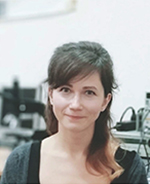Abstract
Nanostructured hybrid materials nowadays are prospective for utilizing them as an active media in novel photovoltaic and optoelectronic devices, such as solar cells and light-emitting diodes. An implementing of lead sulfide quantum dots (PbS QDs) and lead-based perovskite films and nanocrystals (NCs) for future photonic devices with a focus on their optical properties will be discussed.
While designing the nanostructured complex materials one of the main points that should be concerned is the interaction of the material compounds which can result, for instance, in the desired increase of the charge transfer efficiency or in the uncontrollable quenching of luminophore emission. The enhancement of the optical properties, such as absorbance and emission of nanoparticles, is achieved by the fabrication of hybrid material with plasmonic nanoparticles. In particular, I will discuss strong enhancement of near‐infrared emission of PbS QDs induced by Cu2−xSe semiconductor plasmonic NCs both embedded into nanoporous silicate matrix which comes from resonant interaction of QD optical transition dipole with the near field of plasmons of semiconductor plasmonic NCs. Photocurrent and fill‐factor enhancements in meso‐superstructured perovskite solar cells with resonant silicon NPs resulted in increased light absorption will be also discussed. Another important issue in implementing of the nanostructured materials is the stability of their morphology and optical responses while operating at ambient conditions. Here, the optical properties of highly luminescent colloidal perovskite NCs (CsPbX3, where X=Cl/Br, Br, I) embedded in porous glass or opal matrices will be discussed. The use of a nanoporous glass or opal matrices allow obtaining the samples with blue, green, and red perovskite NCs and their mixtures possessing reproducible optical characteristics that are almost similar to that of colloidal solution. Such matrices also prevent the fast degradation of nanocrystals both at the storage in ambient and under UV-light exposure/increasing of the humidity.
Biography

Instructors/Speakers
Prof. Elena V. USHAKOVA
Associate Professor
Department of Materials Science and Engineering
City University of Hong Kong
Date & Time
25 Sep 2019 (Wednesday) 14:00 – 15:00
Venue
E11 – 1028
Organized by
Department of Physics and Chemistry

